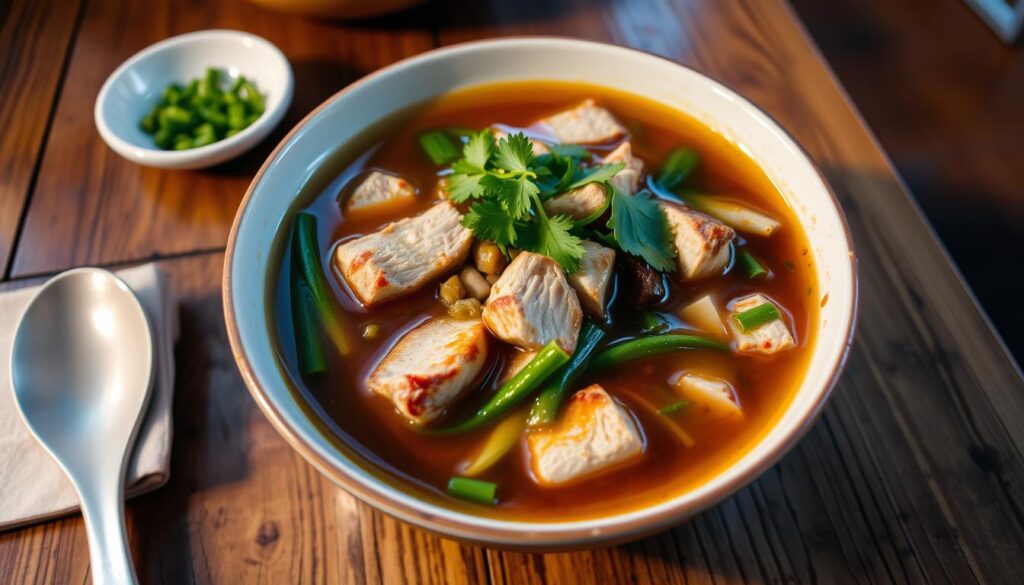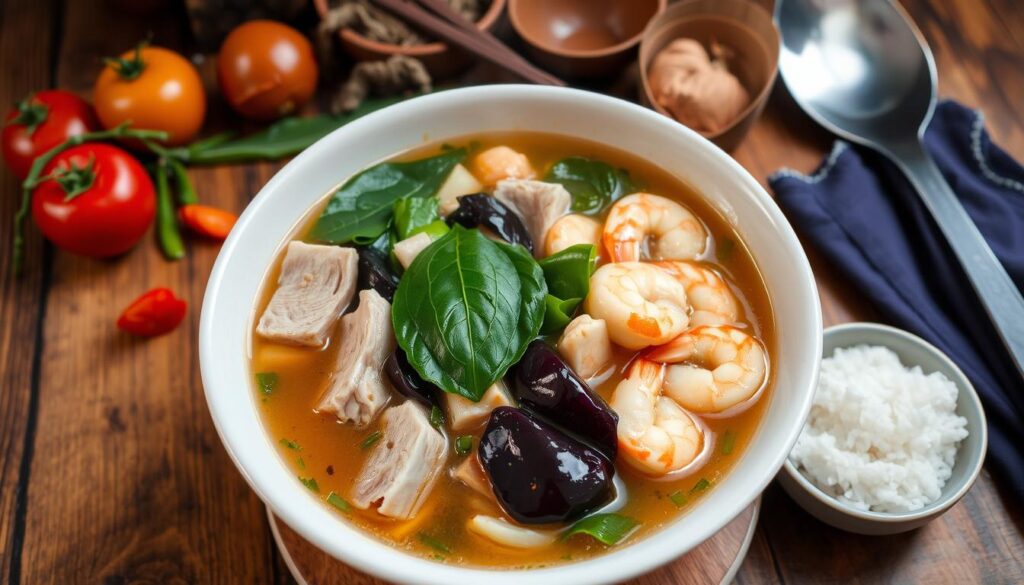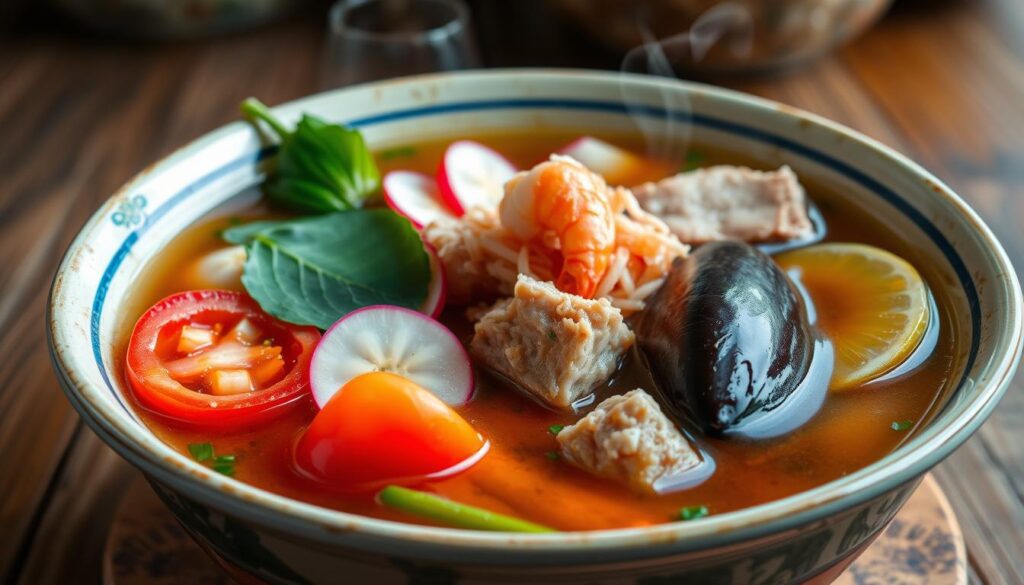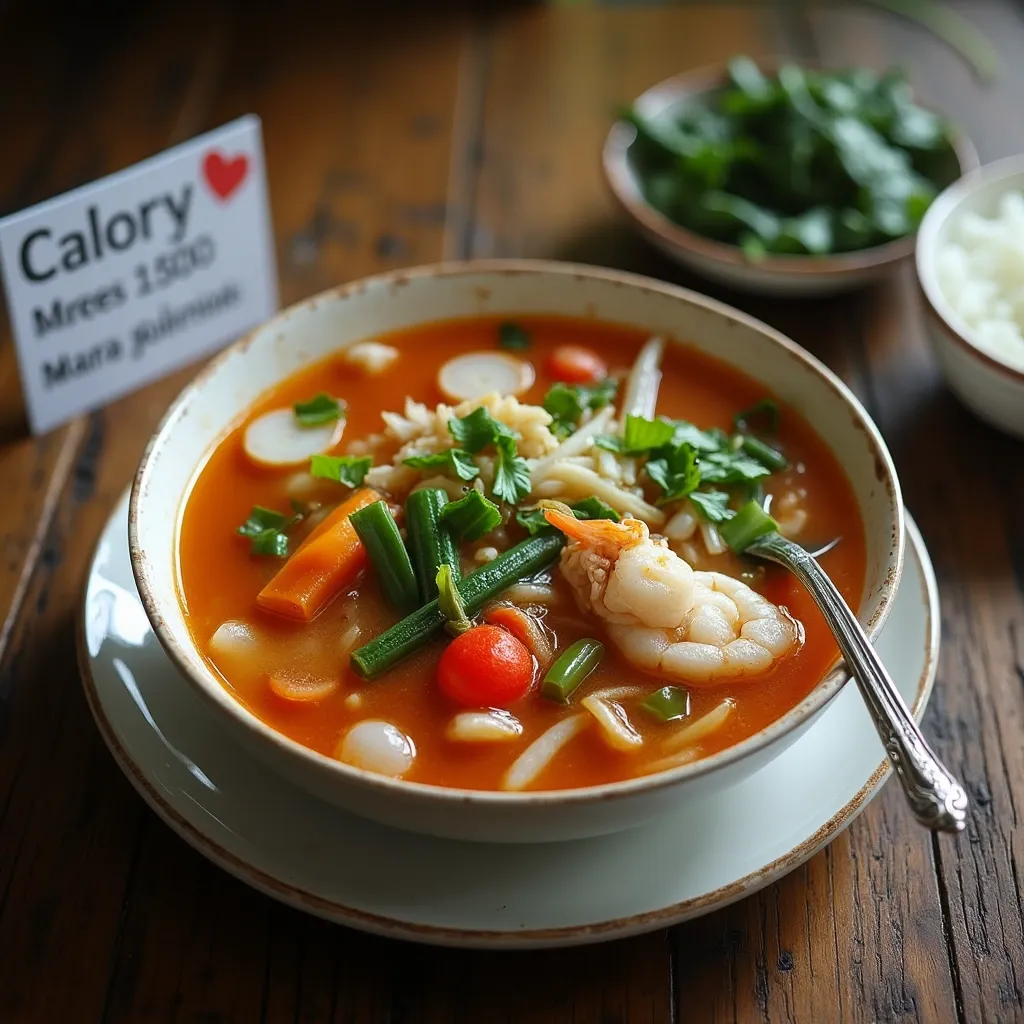Sinigang is a favorite Filipino dish known for its sour taste, thanks to tamarind or other souring agents. It’s a comforting dish that many families love, featuring various meats and fresh veggies. People often wonder: is sinigang high in calories?
The answer depends on the ingredients and how it’s made. But, traditional sinigang is mostly water and veggies, which keeps calories low. A typical serving of pork sinigang has about 150-200 calories. This makes it a nutritious and filling choice among comfort foods.

Key Takeaways
- Sinigang is a popular Filipino comfort food.
- A standard serving of pork sinigang ranges between 150-200 calories.
- High water and vegetable content contribute to its low calorie density.
- Protein content in sinigang can vary from 20-25g per serving.
- Choosing leaner cuts of meat can help reduce overall calories.
Understanding Sinigang: A Cultural Favorite
Sinigang is a beloved dish in Filipino cuisine, known for its sour taste from tamarind. It holds a special place in many Filipino hearts and homes. The recipe varies by region, blending local ingredients and family secrets.
Sinigang can have different proteins like pork, beef, shrimp, and fish. This makes it appealing to many tastes. It also includes colorful veggies like radish, eggplant, and water spinach, adding flavor and nutrition.
Making sinigang is easy, taking about 90 minutes to cook and 2 hours total. It serves around eight people, perfect for family dinners or gatherings. Each bite of sinigang brings people together, fostering a sense of community and togetherness.

What Makes Sinigang Unique?
Sinigang is special because of its unique flavors, thanks to its tangy tamarind base. This makes it different from soups like Thailand’s Tom Yum. It’s a favorite in the Philippines, loved for family meals and everyday dishes.
The variety of sinigang ingredients shows the Philippines’ rich farming. You can find different versions like sinigang na hipon (shrimp) and sinigang na salmon. Each family has its own twist, making it even more special.

But tamarind isn’t the only sour ingredient. Fruits like guava, calamansi, and kamias also add to the flavor. This flexibility keeps sinigang a key part of Filipino food, using fresh, local ingredients for delicious meals.
Nutritional Content of Traditional Sinigang
Traditional sinigang is packed with sinigang ingredients that boost its nutritional value. The dish’s nutritional profile changes based on the meats and veggies used. For example, pork belly adds protein, while shrimp brings omega-3 fatty acids.
Vegetables like daikon radish, eggplants, and water spinach add flavor and fiber. Tomatoes and long green peppers bring vitamin C, key for a strong immune system. Sinigang offers 6.6 milligrams of vitamin C per serving, supporting a balanced diet.
Sinigang is low in calories but filling, making it great for those watching their diet. It’s a guilt-free meal option. The mix of sinigang ingredients and their nutrients highlights the dish’s health benefits.
| Nutritional Component | Per Serving |
|---|---|
| Fats | 80 grams |
| Saturated Fats | 29 grams |
| Cholesterol | 108 grams |
| Sodium | 856 grams |
| Potassium | 383 grams |
| Carbohydrates | 30 grams |
| Sugar | 1 gram |
| Protein | 15 grams |
| Calcium | 33 milligrams |
| Iron | 1 milligram |
| Vitamin C | 6.6 milligrams |
Is Sinigang High in Calories?
The calories in sinigang depend on the meat used. This Filipino soup can be made in many ways, changing its calorie count. Knowing how different ingredients affect sinigang’s calories helps us understand its nutritional value.
Calories from Different Meat Choices
A serving of pork sinigang has about 150-200 calories. Most of these calories come from protein and fat. For example, pork sinigang has 20-25 grams of protein, which is good for muscles and health.
Choosing leaner meats like fish or shrimp makes sinigang lower in calories. Yet, it keeps the essential nutrients. Here’s a comparison:
| Meat Choice | Calories (per serving) | Protein (g) | Fat (g) |
|---|---|---|---|
| Pork | 150-200 | 20-25 | 5-10 |
| Fish | 100-150 | 15-20 | 2-5 |
| Shrimp | 90-130 | 18-22 | 1-3 |
Vegetable Contributions to Overall Calories
Vegetables in sinigang add very few calories but lots of nutrients. Spinach and radishes, for example, are low in calories but full of vitamins and minerals. They make sinigang a nutritious and filling meal.
The mix of meat and vegetable nutrients makes sinigang a great choice for those watching their calories. It’s a balanced dish that meets many dietary needs.
Popular Ingredients in Sinigang
Sinigang is a beloved dish known for its unique flavors and ingredients. It features a variety of common ingredients that enhance both taste and nutritional value. Traditional sinigang often includes proteins like pork belly, shrimp, or fish, giving it a versatile foundation. Each choice of protein imparts different textures while impacting the overall calorie count.
The star of sinigang is undoubtedly the souring agent, most commonly young tamarind. This ingredient provides the dish with its signature tang. Alternative souring agents such as guavas, bilimbi, and green mangoes add a delicious twist, reflecting the dish’s many sinigang variations.
A generous mix of fresh vegetables plays an essential role in sinigang. Vegetables like water spinach (kangkong), string beans (sitaw), and eggplant offer vital vitamins and a delightful contrast to the flavors. These ingredients not only promote health benefits but also contribute texture and color to the soup, making it more appealing.
The adaptability of sinigang allows for numerous versions tailored to personal preferences. Ingredients can vary significantly, making each preparation unique while maintaining the dish’s comforting essence. These adaptations cater to a range of tastes while highlighting the role of fresh produce in creating a well-rounded meal.
| Ingredient | Type | Nutritional Benefits |
|---|---|---|
| Pork Belly | Protein | Rich source of protein and essential fatty acids |
| Shrimp | Protein | Low in calories, high in protein, provides important minerals |
| Young Tamarind | Souring Agent | High in antioxidants, promotes digestive health |
| Water Spinach | Vegetable | High in vitamins A and C, promotes healthy skin |
| String Beans | Vegetable | Rich in fiber, supports digestive health |
| Eggplant | Vegetable | Low in calories, high in antioxidants |
The interplay of proteins and fresh vegetables enriches sinigang, making it a nourishing comfort food that resonates with many. It is not just a meal; it represents a cultural experience serving warmth and community, deeply embedded in culinary traditions.
The Impact of Cooking Methods on Calorie Count
Cooking methods greatly affect the calorie count in sinigang. Boiling is a low-calorie method because it uses little fat. Using fresh ingredients boosts nutrition and supports healthy cooking.
Controlling seasonings, like fish sauce or tamarind mixes, is key. This helps keep the dish tasty without adding too many calories.
Choosing healthier cooking methods is vital to lower calorie counts. Baking, roasting, and air frying use less fat. They also help keep the dish’s flavor and texture.
These methods allow for leaner cuts of pork. For example, tenderloin and sirloin are good choices. They have fewer calories and more protein.
The American Heart Association suggests limiting saturated fat to 13 grams a day. Choosing leaner cuts helps avoid high calorie counts. This supports a balanced diet.
In conclusion, changing cooking methods can significantly impact calorie counts and nutrition. Using fresh ingredients and smart cooking techniques makes sinigang healthier.
Calorie Comparison: Sinigang vs Other Comfort Foods
Looking at the calories in sinigang and other comfort foods shows their nutritional value. Sinigang, tom yum soup, and chicken noodle soup have different calorie counts. This comparison highlights their health benefits.
Sinigang vs. Tom Yum Soup
Sinigang and tom yum soup both have a sour taste. But, sinigang has fewer calories because it’s full of vegetables. Tom yum soup might have more calories, depending on the ingredients used.
Both soups are good for you, but sinigang’s veggies make it even healthier.
Sinigang vs. Chicken Noodle Soup
Sinigang is a lighter choice than chicken noodle soup. Chicken noodle soup has more calories because of carbs and richer ingredients. Sinigang uses fresh veggies and lean proteins, making it a nutritious and filling option.
| Dish | Calories per Serving | Main Protein Source | Vegetable Content |
|---|---|---|---|
| Sinigang | 150-200 | Pork, Shrimp, or Fish | High |
| Tom Yum Soup | 200-300 | Shrimp or Chicken | Medium |
| Chicken Noodle Soup | 300-400 | Chicken | Low-Medium |
How to Make a Healthier Sinigang
Making a healthier sinigang is a fun journey, thanks to the right ingredients. Choose lean meats like fish or shrimp to cut down on fat. This keeps the soup’s rich flavors while being healthier.
Adding a mix of fresh veggies makes the dish more nutritious. Tomatoes, onions, and yellow sweet potatoes add taste and vitamins. For more nutrition, try okra, bok choy, or spinach.
Using fresh tamarind boosts the soup’s natural taste without added sugars. This keeps sinigang true to its roots while being healthier.
Seasoning is also key. Cutting down on sodium-based seasonings helps those watching their salt intake. Recipes with exact ingredient amounts offer great health-focused tips.
With these smart choices, sinigang stays a beloved dish in Filipino homes. It meets health goals while being flexible for personal tastes. Enjoy making a nutritious meal that you love.
Tips for Reducing Calories in Sinigang
Sinigang is a favorite Filipino dish that can be made healthier. Making a few simple changes can make it a healthy sinigang that’s tasty and good for you. Here are some cooking tips to help you cut calories without losing flavor or nutrients.
Leaner Meat Options
Choosing lean meats or seafood is a big step towards reducing calories in sinigang. For instance, using leaner meats like skinless chicken or low-fat fish can cut down on calories and fat. Here are some lean choices:
- Skinless chicken breast
- White fish such as cod or tilapia
- Shrimp or prawns
These options make your meal protein-rich and lower in calories.
Vegetable Alternatives for Less Caloric Density
Adding high-fiber, low-calorie veggies can make sinigang more filling without adding many calories. Spinach, zucchini, and bean sprouts are great choices. They not only make your sinigang healthier but also add more nutrients:
| Vegetable | Calories per Serving | Fiber (g) |
|---|---|---|
| Spinach (1 cup) | 7 | 0.7 |
| Zucchini (1 medium) | 33 | 1.0 |
| Bean sprouts (1 cup) | 31 | 1.5 |
These changes help you enjoy a full meal without too many calories. They support a balanced and healthy sinigang.
Health Benefits of Sinigang
Sinigang is a nutritious dish, packed with health benefits. It’s full of water and veggies, helping you stay hydrated and feel full. A serving has about 150-200 calories, making it a satisfying meal.
The sinigang health properties shine in its antioxidants, like tamarind. Tamarind is rich in vitamins C and E, fighting oxidative stress. These antioxidants also reduce inflammation and boost overall health.
Each serving of sinigang has 20-25g of protein, thanks to the meat. Fish in sinigang adds omega-3s, good for the heart and brain. It also has 2-4g of dietary fiber, aiding digestion.
Plus, sinigang is a nutritional powerhouse. It’s a good source of vitamins and minerals. It gives you 35-50% of your daily Vitamin C and 10-20% of potassium. Tamarind also adds magnesium, supporting bones and metabolism. Sinigang is a tasty way to get many nutrients and health benefits.
Potential Concerns: Sodium Levels in Sinigang
Sinigang is loved for its taste and health benefits. But, it has a lot of sodium. A serving can have 500 to 1000 milligrams of sodium. This is because of ingredients like tamarind soup base and fish sauce.
A 22g packet of tamarind soup base has 500-700 milligrams of sodium. Fish sauce adds even more, with about 1,400 milligrams in just one tablespoon. This can be a big problem for people who need to watch their sodium.
The American Heart Association says adults should eat no more than 2,300 milligrams of sodium a day. The goal is 1,500 milligrams, which is better for those with high blood pressure. So, it’s important to think about dietary considerations when eating sinigang.
Here’s a table to show how much sodium is in some ingredients:
| Ingredient | Sodium Content (mg) |
|---|---|
| Tamarind Soup Base (22g packet) | 500-700 |
| Fish Sauce (1 tbsp) | 1400 |
| Shrimp Paste (1 tsp) | 100 |
To make sinigang healthier, try using low-sodium broth instead. You can also use less salt. This way, sinigang can stay tasty but also be good for your health.
Conclusion
Sinigang is a flavorful and adaptable meal that’s perfect for comfort food lovers. It’s low in calories but packed with nutrients. This makes it great for those watching their calorie intake but wanting to enjoy tasty meals.
Adding ingredients like mung beans makes sinigang even better for weight management. It’s a low-calorie option that’s easy to incorporate into your diet.
Using ground meat for convenience and fish for omega-3 fatty acids boosts sinigang’s health benefits. But, it’s important to watch sodium levels, as some fish can be high in salt. This is key for those with high blood pressure.
Enjoying sinigang as part of a balanced diet is a great way to enjoy its unique flavors. By trying different ingredients and watching portion sizes, sinigang can be a healthy part of your lifestyle.
FAQ
Is sinigang considered a high-calorie dish?
Sinigang is usually low in calories, with 150-200 calories per serving. This depends on the meat and veggies used. Its high water and veggie content make it filling without too many calories.
What are the key ingredients in a traditional sinigang recipe?
Traditional sinigang includes a protein like pork, shrimp, or fish. It also has veggies like water spinach, radish, and eggplant. The sour taste comes from tamarind.
How can I make sinigang healthier?
For a healthier sinigang, use lean proteins like fish or shrimp. Add more veggies and use fresh tamarind for flavor. Cutting down on sodium-rich seasonings is also good.
How do the cooking methods affect the calories in sinigang?
Boiling is a low-calorie cooking method for sinigang. It uses little added fat. This keeps the dish’s natural flavors and nutrients.
What vitamins and minerals can I find in sinigang?
Sinigang is full of vitamins A and C from its veggies. It also has minerals from the protein and fiber for good digestion.
How does sinigang compare to other comfort foods in terms of calorie content?
Sinigang has fewer calories than many comfort foods. For example, chicken noodle soup or Tom Yum soup have more calories because of extra carbs and fats.

